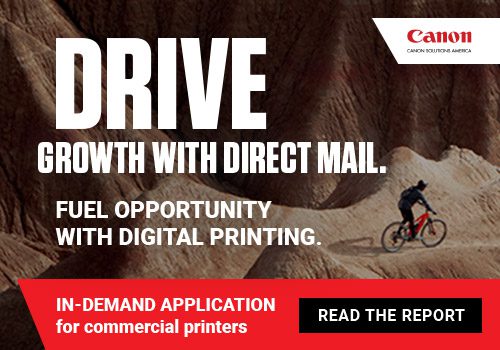Earlier this year, HP made its first foray into the dye-sub textile market, introducing the Stitch family of printers. Santi Morera, General Manager, Global Head of Graphic Solutions Business, and Joan Perez Pericot, General Manager Large Format Graphics Division, explain why it’s the right move at the right time for HP as they speak to Deborah in the fabulous HP booth at ISA Sign Expo.
‘Imagination is Unlimited’
HP has enjoyed success in a number of markets, so why take the leap into textiles?
Santi: At the end of the day, we listen carefully to our customers. We can leverage the things we have already achieved, to bring to the future. We are good at listening and understanding trends, and customers participate a lot. No magic, just hard work and keeping our ears open!
‘We are expanding our presence in a very significant way’
HP is known for looking to the future, and carving out its own path, in many cases shaping it for the industry as a whole. Why is it the right time for textile?
Joan: Stitch was a natural step forward. Latex has been a big business, but we are continually listening to our customers, and our customers want to print on more fabrics, and do more with textile. There is huge growth in polyester for digital printing, sportswear, signage, and so on. So, we are leveraging our assets and disrupting dye-sublimation. We’re not going to stop here, it’s a journey, and there are lots of opportunities, but it is the first step.
‘At the end of the day, we listen carefully to our customers’
As we know, a standalone piece of machinery isn’t enough for prosperous printing. How do the Stitch machines fare in terms of workflow – and how does HP’s technology in general combat finishing issues in wide-format?
Joan: Our approach is to put together an end-to-end solution. We also have HP media for the Stitch, we have an HP version of Ergosoft RIP software, we have media programs with key media vendors across countries, certify or test solutions up front. From a finishing point of view, we have certified several solutions teaming up with market leaders in all solutions, be it sewing, calendaring, for example. It’s important to have wide solutions, fully compatible with our products.
‘We’re taking away ‘print and pray’
During the podcast, Deborah describes the PrintOS platform as ‘misunderstood’. What would be a pertinent clarification of the PrintOS features that can help users and potential customers better understand how it can boost efficiency and quality?
Joan: HP Stitch, like the Latex machines and many other HP printers, are what we call ‘smart printers’. They are connected to PrintOS platform to bring back information to our users in terms of production, efficiencies and how they are managing shifts. They can also access applications and media profiles directly through the printer. Customers can also configure your fleet for performance and colour consistency, and monitor remotely – there are endless possibilities when it comes to managing the fleet.
Santi: PrintOS is simply a secure, cloud-based platform from HP to help you manage your printer more efficiently and effectively. When users are looking for media profile, you can have the information in The Cloud, and it can be installed in a nearby printer, or a printer 10,000 miles from you. You can use PrintOS for remote management of press, getting service for press, monitoring fleet performance, workflow, and more. In the end, is just a platform that is home to many different applications. Some users are just using a few, others are using many.
‘We are reinventing dye-sublimation, making it easier’
Now that the first HP Stitch printers are out in the world, with the S300 and S500 being debuted at the Sign Expo, while the S1000 was first on display a month later at FESPA Munich in May, which businesses will be most interested in getting their mitts on a Stitch?
Joan: There are two types of customer that we’re targeting; one is customers more focused on signage and decoration, who have an increasing demand for soft signage, décor – in those markets, we see textiles as an extension of their product line, and it compliments their Latex technology or Designjet technology. The other is companies that are 100% focused on textiles; fashion, sportswear, garment. Those markets are already printing with dye-sub. What HP is doing is reinventing dye sublimation, and making it easier and much more predictable. In terms of each machine, the S300 is the entry level, to test the waters. S500 is aimed at industrial and production print, while the S1000, the 3.2m, is more designed for superwide applications such as curtains, bedding, and soft signage.
Santi: Ten years ago, how many businesses had access to printing on signage? Probably very few. Now, there are a lot more. Now, dye-sub will be more accessible to people that wouldn’t have had that access in the past, thanks to HP.
‘We look at the trends, we look at how customers work, we look at the future, and we do it’
And finally, as a business with one eye on the future at all times, now that it has made a major play for the textile market, what are HP’s views on the future of the market?
Joan: The question customers should be asking is, how can textiles help your business? We expect double digit growth in digital textile print in five years. There are many reasons why textiles are popular, from being easy to transport and install, to the human touch, as well as making it better adopted in retail, and financial savings. There are also increases in environmental regulations brands want greener materials, so this will be better for company’s environmental footprint.
Santi: Look at what HP has done in markets such as graphics, commercial printing, publishing, now in the labels market, and packaging. Today has been the first phase, but the market is big, dye-sub is just one technology, and HP will continue to help customers grow. This is just the beginning.
You can listen to more on the HP Stitch and the textile market in this podcast with Ester Sala Alborná.
 Karis Copp is a UK-based writer, journalist and communications expert. With a background as an editor and public relations specialist in the print industry, she now works on a freelance basis covering events, writing on industry news and trends, and working with businesses to help them tell their stories and connect with their customers. Follow her on Twitter @KarisCoppMedia
Karis Copp is a UK-based writer, journalist and communications expert. With a background as an editor and public relations specialist in the print industry, she now works on a freelance basis covering events, writing on industry news and trends, and working with businesses to help them tell their stories and connect with their customers. Follow her on Twitter @KarisCoppMedia












